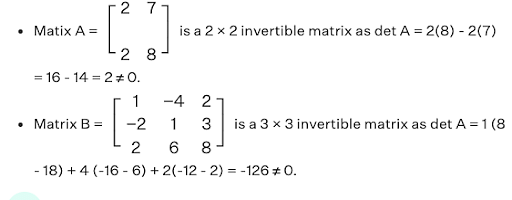Find the inverse of each of the matrices,if it exists.\(\begin{bmatrix} 1 & 3 & -2\\ -3 & 0 & -5\\ 2&5&0 \end{bmatrix}\)
Solution and Explanation
Let A=\(\begin{bmatrix} 1 & 3 & -2\\ -3 & 0 & -5\\ 2&5&0 \end{bmatrix}\)
We know that A = IA
\(\begin{bmatrix} 1 & 3 & -2\\ -3 & 0 & -5\\ 2&5&0 \end{bmatrix}\)=\(\begin{bmatrix} 1 & 0 & 0\\ 0 & 1 & 0\\ 0&0&1 \end{bmatrix}\)A
Applying \(R_2 → R_2 + 3R_1\) and \(R_3 → R_3 − 2R_1\), we have:
\(\begin{bmatrix} 1 & 3 & -2\\ 0 & 9 & -11\\ 0&-1&4 \end{bmatrix}\)=\(\begin{bmatrix} 1 & 0 & 0\\ 3 & 1 & 0\\ -2&0&1 \end{bmatrix}\)A .
Applying \(R_1 → R_1 + 3R_3\) and \(R_2 → R_2 +8R_3\), we have:
\(\begin{bmatrix} 1 & 0 & 10\\ 0 & 1 & 21\\ 0&-1&4 \end{bmatrix}\)=\(\begin{bmatrix} -5 & 0 & 3\\ -13 & 1 & 8\\ -2&0&1 \end{bmatrix}\)A
Applying \(R_3 → R_3 + R_2\) , we have
\(\begin{bmatrix} 1 & 0 & 10\\ 0 & 1 & 21\\ 0&0&25 \end{bmatrix}\)=\(\begin{bmatrix} -5 & 0 & 3\\ -13 & 1 & 8\\ -15&1&9 \end{bmatrix}\)A
Applying \(R_3 → \frac{1}{25}R_3\) , we have
\(\begin{bmatrix} 1 & 0 & 10\\ 0 & 1 & 21\\ 0&0&1 \end{bmatrix}\)=\(\begin{bmatrix} -5 & 0 & 3\\ -13 & 1 & 8\\ -\frac{3}{5}&\frac{1}{25}&\frac{9}{25} \end{bmatrix}\)
Applying \(R_1 → R_1 -10R_3\) and \(R_2 → R_2 -21R_3\), we have:
\(\begin{bmatrix} 1 & 0 & 0\\ 0 & 1 & 0\\ 0&0&1 \end{bmatrix}\)=\(\begin{bmatrix} 1 & -\frac25 & -\frac35\\ -\frac25 & \frac{4}{25} & \frac{11}{25}\\ -\frac{3}{5}&\frac{1}{25}&\frac{9}{25} \end{bmatrix}\)A
therefore A-1=\(\begin{bmatrix} 1 & -\frac25 & -\frac35\\ -\frac25 & \frac{4}{25} & \frac{11}{25}\\ -\frac{3}{5}&\frac{1}{25}&\frac{9}{25} \end{bmatrix}\)
Top Questions on Matrices
- If $M$ and $N$ are square matrices of order 3 such that $\det(M) = m$ and $MN = mI$, then $\det(N)$ is equal to :
- Find the determinant of the matrix \( A = \begin{bmatrix} 2 & 3 \\ 4 & 5 \end{bmatrix} \).
- Let \( A = \begin{bmatrix} 2 & 0 \\ 0 & 3 \end{bmatrix} \). The determinant of \( A^3 \) is:
- If \( A = \begin{bmatrix} 2 & 3 \\ 4 & 5 \end{bmatrix} \), find the determinant of \( A^2 \).
- Sum of two skew-symmetric matrices of the same order is always a/an:
Questions Asked in CBSE CLASS XII exam
- (a) Differentiate $\sqrt{e^{\sqrt{2x}}}$ with respect to $e^{\sqrt{2x}}$ for $x>0$.
- CBSE CLASS XII - 2025
- Continuity and differentiability
A battery of emf \( E \) and internal resistance \( r \) is connected to a rheostat. When a current of 2A is drawn from the battery, the potential difference across the rheostat is 5V. The potential difference becomes 4V when a current of 4A is drawn from the battery. Calculate the value of \( E \) and \( r \).
- CBSE CLASS XII - 2025
- Current electricity
If \(\begin{vmatrix} 2x & 3 \\ x & -8 \\ \end{vmatrix} = 0\), then the value of \(x\) is:
- Nita, Vidur and Mita were partners in a firm sharing profits and losses in the ratio of 3 : 4 : 1. On 1st April 2024, they decided to admit Samir as a new partner. The new profit sharing ratio between Nita, Vidur, Mita and Samir will now be 1 : 1 : 1 : 1. The balance sheet of Nita, Vidur and Mita before Samir’s admission showed machinery at ₹ 6,00,000. On the date of admission, it was found that the machinery is overvalued by 20%. The value of machinery shown in the new Balance Sheet after Samir’s admission will be :
- CBSE CLASS XII - 2025
- Admission of a Partner
Rupal, Shanu and Trisha were partners in a firm sharing profits and losses in the ratio of 4:3:1. Their Balance Sheet as at 31st March, 2024 was as follows:

(i) Trisha's share of profit was entirely taken by Shanu.
(ii) Fixed assets were found to be undervalued by Rs 2,40,000.
(iii) Stock was revalued at Rs 2,00,000.
(iv) Goodwill of the firm was valued at Rs 8,00,000 on Trisha's retirement.
(v) The total capital of the new firm was fixed at Rs 16,00,000 which was adjusted according to the new profit sharing ratio of the partners. For this necessary cash was paid off or brought in by the partners as the case may be.
Prepare Revaluation Account and Partners' Capital Accounts.- CBSE CLASS XII - 2025
- Partnership Accounts
Concepts Used:
Invertible matrices
A matrix for which matrix inversion operation exists, given that it satisfies the requisite conditions is known as an invertible matrix. Any given square matrix A of order n × n is called invertible if and only if there exists, another n × n square matrix B such that, AB = BA = In, where In is an identity matrix of order n × n.
For example,
It can be observed that the determinant of the following matrices is non-zero.
